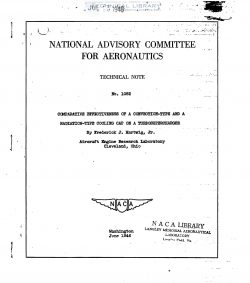naca-tn-1082
- Version
- 127 Downloads
- 667.34 KB File Size
- 1 File Count
- December 2, 2016 Create Date
- December 2, 2016 Last Updated
National Advisory Committee for Aeronautics, Technical Notes - Comparative Effectiveness of a Convection Type and a Radiation Type Cooling Cap on a Turbosupercharger

An investigation was made to compare the effectiveness of two
basic methods of cooling a turbosupercharger and to obtain data on the
temperature level and distribution in the turbine wheel. Turbine-
wheel temperatures were obtained for various conditions of cooling-air
mass flow, exhaust-gas temperature, and exhaust-gas mass flow. Modi—
fied forms of the standard cooling caps were used to allow for the
installation of temperature-measuring devices.
The convection-type cap that amp] -oys a Jet of air blowing on the
rim of the wheel gave temperatui e reductions of the order of 150° F
when the air flow was increased from O to 5 pounds per minute (average
flow for a flight installation), and further temperature reductions
were attained with increased air flow. With the radiation-type cap
in which the cooling air never comes in contact with the turbine wheel,
maximum reductions in wheel temperature of 20° F to 50° F were attained
with air flows up to 3 pounds per minute and no additional cooling was
obtained with greater flows.
The efficiency and power of a turbine can be increased with
increases in gas temperature. The operating gas temperature being
limited by the capacity of the blade and wheel material to withstand
centrifugal and other stresses at high temperatures, cooling of the
wheel will permit the use of a higher gas temperature or of a lighter
wheel for the same gas temperature, stress, and life.
Two basic methods of cooling are used in cooling caps for turbine
wheels of turbosuperchargers. One cap employs a Jet or Jets of cooling
air directed on the rim of the wheel Just inside the blade ring and is
commonly known as a convection cooling cap. The other type, called a _
radiation cooling cap, has a cool surface close to the wheel to which __
the heat from the wheel may radiate.
Although it is known from tests conducted by the General Electric
Company that the radiation cap has a lesser cooling effect than the
convection cap, other factors influence the selection of one cap or the
other. Under certain conditions of engine operation involving high
fuel—air ratios and high exhaust—gas temperatures, air introduced into
the exhaust system of a turbosupercharger will combine with unburned fuel
and cause afterburning, which results in excessive temperatures and may
cause turbine-wheel failure.
| File | Action |
|---|---|
| naca-tn-1082 Comparative Effectiveness of a Convection Type and a Radiation Type Cooling Cap on a Turbosupercharger.pdf | Download |

Comment On This Post